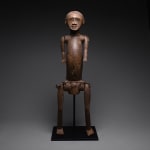Zaramo Male Puppet Figure, 20th Century CE
Wood
PF.6092 (LSO)
Further images
This striking piece is a funeral doll, attributed to the Zaramo group of Tanzania. The piece bears the usual Zaramo characteristics – elongated torso, short limbs and a large, round...
This striking piece is a funeral doll, attributed to the Zaramo group of Tanzania. The piece bears the usual Zaramo characteristics – elongated torso, short limbs and a large, round head – with the addition of joints in arms and legs. The construction is unusual, with a trefoil hip arrangement that supports the legs – attached by cords – and a circular base that would help the individual to “sit”. The patina of the figure suggests that it may once have been dressed in textile clothing. The face is very well rendered, with a scooped, concave face in an otherwise almost spherical head, an inverted T-bar nose and slanted eyes with a pursed mouth. The hands and feet are particularly small, the feet added secondarily.
The Zaramo are comparatively little understood in the African art world as Tanzania and related areas have received little attention from western scholars. They are agrarian farmers and traders, with a comparatively austere artistic heritage compared to most West African groups. The culture is one of seven tribes that are based around Dar-es-Salaam, which are artistically homogeneous due to their extensive trade links and high level of mobility.
The Zaramo are perhaps best known for their dolls, reductivist anthropomorphic forms rendered as fat columns with vestigial limbs and breasts, and a crested (often bipartite) block as a head, resembling Kwere pieces. Their masks are block-like with protuberant, angular foreheads and thick features, while they are also known for their funerary pieces, of which this is a superb example. These are technically dolls but can be manipulated- at the funeral of an elder, the nephew of the deceased will speak “through” the doll, praising the dead and lauding his achievements.
This is an impressive and eloquent piece of African art.
The Zaramo are comparatively little understood in the African art world as Tanzania and related areas have received little attention from western scholars. They are agrarian farmers and traders, with a comparatively austere artistic heritage compared to most West African groups. The culture is one of seven tribes that are based around Dar-es-Salaam, which are artistically homogeneous due to their extensive trade links and high level of mobility.
The Zaramo are perhaps best known for their dolls, reductivist anthropomorphic forms rendered as fat columns with vestigial limbs and breasts, and a crested (often bipartite) block as a head, resembling Kwere pieces. Their masks are block-like with protuberant, angular foreheads and thick features, while they are also known for their funerary pieces, of which this is a superb example. These are technically dolls but can be manipulated- at the funeral of an elder, the nephew of the deceased will speak “through” the doll, praising the dead and lauding his achievements.
This is an impressive and eloquent piece of African art.







